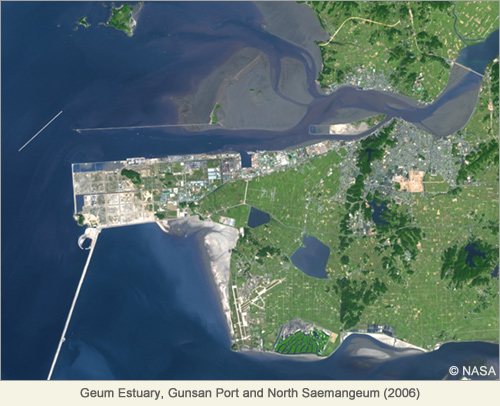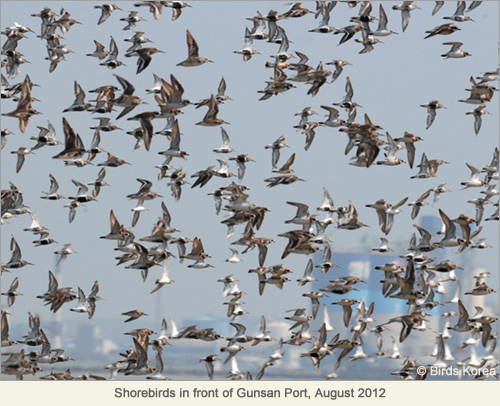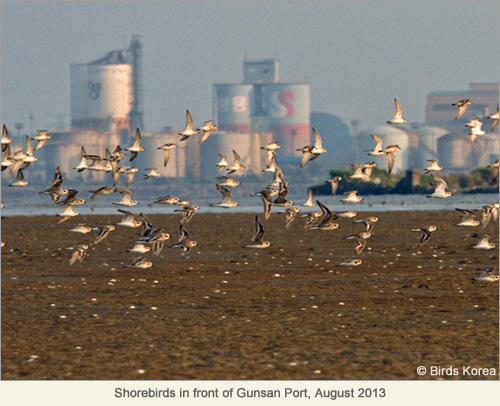Birds Korea, August 18th 2013
The following is a statement of concern by the conservation organisation Birds Korea in response to a recent proposal to construct a new wind farm, with seven large wind turbines, in the outer part of the Geum Estuary(1). As an organisation committed to sustainable development, we support greater conservation of energy and the development of alternative energy resources (including from wind and solar power). However, we only support such development when it is both likely to have a low ecological impact, especially on birds and their habitats, and when it also provides benefits to affected human communities.
In the case of the present proposal:
The Geum Estuary is now the nation’s most important remaining shorebird site, supporting several globally-threatened waterbird species(2, 3, 4, 5);
A review of scientific literature and communication with leading shorebird experts, confirms that wind turbines, if poorly located, can kill birds through collision and cause increased disturbance(6, 7, 8, 9). While there is still little published evidence on the impacts of wind turbines on shorebirds, this is at least in part because some national governments have already legislated against or rejected the construction of wind farms within estuaries or close to important shorebird sites(6, 7).
In recognition of existing conservation guidance and obligations (under domestic laws; the Ramsar Convention(10), including e.g. Ramsar Resolution X1.10(11); the Aichi Biodiversity Targets within the Convention on Biological Diversity(12); and the United Nations’ Precautionary Principle(13)) Birds Korea advises strongly against the construction of wind turbines within or close to the Geum Estuary. We also advise against the construction of wind-turbines in any other wetland of international importance or within migration corridors used by large numbers of migratory birds.
National and International Importance of the Geum Estuary
In the case of the Geum Estuary, Birds Korea members have conducted research on shorebirds and other bird species there since 1998(14), most recently in mid-August 2013. Many of our count data have been published in scientific journals and reports, most especially during intensive fieldwork in the estuary in 2006, 2007 and 2008, conducted in collaboration with the Australasian Wader Studies Group(e.g. 15, 16, 2, 3, 5). The area has also been surveyed by other government and non-government researchers since at least the late 1990s.(17, 18, 19, 4, 20)
Following closure of the Saemangeum seawall in 2006, our count data confirm that the Geum Estuary became the ROK’s most important remaining shorebird site. In 2007, during repeat Birds Korea surveys, we counted more than 100,000 shorebirds in the Geum Estuary during northward migration (April-May), and c. 46,000 shorebirds during southward migration (August-October)(2). The majority of these shorebirds were counted at or close to Yubu Island.
In total, in the period 2006-2008 and again between 2009 and 2013, we recorded at least eight globally-threatened or near-threatened waterbird species on tidal-flats around Yubu Island in Ramsar-defined internationally important concentrations of more than 1% of population. These include one Critically Endangered species (Spoon-billed Sandpiper), two Endangered species (Black-faced Spoonbill and Nordmann’s Greenshank) and four Vulnerable Species. An additional 12 species of shorebird also occur regularly in the outer part of the Geum Estuary in internationally important concentrations, including between 10% and 50% of the total population of the distinctive osculans subspecies of Far Eastern Oystercatcher (21).
Our own data and data from other researchers (including researchers within the Ministry of Environment) thus confirm that tidal-flats within the Geum Estuary, most especially around Yubu Island, are of outstanding national and international importance. This importance has been recognised in several conservation designations and initiatives, including listing of the outer Geum Estuary as a globally Important Bird Area(22) and designation of part of the area around Yubu Island as a Ramsar site in 2009(23).
Threats to Birds posed by wind-turbines inside the Geum Estuary
Main potential threats to birds from the development of a wind farm include disturbance caused during construction; disturbance caused during operation and maintenance; collision with turbines; and collision with related infrastructure (including cables, lights, and additional buildings)(6, 7). Additional impacts within the Geum Estuary might also include changes in tidal-patterns and reduction of landscape uniqueness (resulting in reduced potential for eco-tourism and hence reduced investment in shorebird and waterbird conservation).
An expert review from Europe concludes that the risk to birds from wind-turbines “is likely to be greater on or near areas regularly used by large numbers of feeding or roosting birds, or on migratory flyways or local flight paths”. This review therefore advises that “developers should avoid areas supporting…a high density of wintering or migratory waterfowl and waders (shorebirds) where important habitats might be affected by disturbance or where there is potential for significant collision mortality.”(7)
The Geum Estuary supports a high density of wintering and migratory waterbirds. The vast majority of shorebirds within the estuary use tidal-flats close to Yubu Island either for feeding or roosting. Movements of shorebirds appear to be highly complex, as the system is strongly tidal with two high-tides every 24-hours. On highest tides, at least until 2011, large numbers of shorebirds from the Geum Estuary crossed the Geum River and flew over Gunsan Port to roost within Saemangeum(2, 5). In 2011, 2012 and 2013, large numbers of shorebirds were observed using existing sea-walls to roost on, including those extending west from Yubu Island (a possible location for the proposed new wind-farm). As in other areas, movements to and from shorebird roosts takes place both during the day and night(24), and in all weather conditions.
The complexity and high frequency of shorebird movements within the Geum Estuary therefore means that large numbers of birds might on occasion be at substantial risk from collision with poorly-located wind turbines and related infrastructure.
Birds Korea members have also conducted basic bird research in areas seaward of the Geum Estuary. A high diversity of bird species has been recorded in areas between 3km and 10km west and northwest of Gunsan Port, including seabirds and migrant waterbirds and landbirds. In this area, as in other parts of the Republic of Korea, many landbirds migrate along or close to the coast, often in narrow migration corridors(5), exposing them to a high potential risk of collision with poorly-located wind turbines.
Locating wind turbines in areas that are distant from large concentrations of birds greatly reduces the likelihood of collision and disturbance.
Recommendations
Based on best information, we therefore recommend that:
No further development of wind farms should be permitted within or close to the Geum Estuary (or within or close to other sites of national or international importance to birds).
In especially sensitive areas (such as on Yubu Island), alternative sources of electricity, perhaps solar power, should be developed.
Much greater research needs to be conducted on the potential and actual impacts of existing wind turbines on wildlife, including birds and bats, both close to the Geum Estuary and nationwide.
Findings of such research need to be made publicly available, to help inform local stakeholders, decision-makers and energy companies.
The future development of wind energy needs to respond appropriately to existing conservation obligations, with future wind farms located in areas of least ecological impact.
References
- http://jeollailbo.com/news/general_view.php?code4=PO0100001&An=394579
- Moores N., Rogers D., Koh C-H, Ju Y-K, Kim R-H & Park M-N. 2007. The 2007 Saemangeum Shorebird Monitoring Report. Birds Korea publication, Busan. At: /Habitats/Wetlands/Saemangeum/Downloads/Birds-Korea-SSMP-Report-2007.pdf
- Moores, N., Rogers, D., Kim R-H, Hassel, C., Gosbell, K., Kim S-A & Park M-N. 2008. The 2006-2008 Saemangeum Shorebird Monitoring Program Report. Birds Korea publication. At: /Habitats/Wetlands/Saemangeum/Downloads/Birds-Korea-SSMP-Report-2006-2008.pdf
- Lee H-S., Yi J-Y., Kim H-C, Lee S-W. & Paek W-K. 2002. Yubu Island, the Important Waterbird Habitat on the West Coast of Korea and Its Conservation. Ocean and Polar Research. Vol 24(1): 115-121
- .Moores, N. 2012. The Distribution, Abundance and Conservation of the Avian Biodiversity of Yellow Sea habitats in the Republic of Korea. Doctoral thesis, University of Newcastle, Australia.
- Langston, R. & J. Pullan. 2004. Effects of wind farms on birds. Nature and environment 139. Produced by the RSPB and BirdLife International. Council of Europe Publishing.
- Drewitt, A. & R. Langston. 2006. Assessing the impacts of wind farms on birds. Ibis (2006), 148, 29-42.
- Kuvlesky Jr., W., Brennan, L., Morrison, M., Boydston, K. Ballard, B. & F. Bryant. 2007. Wind Energy Development and Wildlife Conservation: Challenges and Opportunities. The Journal of Wildlife Management, Vol. 71, No. 8 (Nov., 2007), pp. 2487-2498. Published by: Wiley on behalf of the Wildlife Society. At: http://www.jstor.org/stable/4496368
- Smallwood, K. & C. Thelander. 2008. Bird Mortality in the Altamont Pass Wind Resource Area. The Journal of Wildlife Management, Vol. 72, No. 1 (Jan., 2008), pp. 215-223 Published by: Wiley on behalf of the Wildlife Society. At: http://www.jstor.org/stable/25097521
- Ramsar Convention, at: http://www.ramsar.org/cda/en/ramsar-home/main/ramsar/1_4000_0__
- Ramsar Resolution XI.10, “Wetlands and Energy Issues” at: http://www.ramsar.org/pdf/cop11/res/cop11-res10-e.pdf
- Aichi Biodiversity Targets within Convention on Biological Diversity, at: http://www.cbd.int/sp/targets/
- The Precautionary Principle, at: http://www.unglobalcompact.org/AboutTheGC/TheTenPrinciples/principle7.htm
- Moores, N. 1999. A Survey of the Distribution and Abundance of Shorebirds in South Korea during 1998-1999: Interim Summary. Stilt 34: 18-29. At: http://www.awsg.org.au/stilt/Stilt-34.pdf
- Rogers, D., Moores, N. & P. Battley. 2006. Northwards Migration of Shorebirds through Saemangeum, the Geum Estuary and Gomso Bay, South Korea in 2006. Stilt 50: 73-89. Published by the Australasian Wader Studies Group. At: http://www.awsg.org.au/stilt/Stilt-50.pdf
- Moores, N., Battley, P., Rogers, D., Park M-N., Sung H-C., van de Kam, J. & K. Gosbell. 2006. Birds Korea-AWSG Saemangeum Shorebird Monitoring Program Report, 2006. Birds Korea publication, Busan. At: /Habitats/Wetlands/Saemangeum/Downloads/Birds-Korea-SSMP-Report-2006.pdf
- Kim J-H., Park J-Y. & Yi J-Y. 1997. Spring and autumn avifauna of western coastal mudflat in Korea. Journal of Korea biota 2: 183-295.
- Yi J-Y. 2003. Critical Habitat in the Yellow Sea from a Korean perspective. Powerpoint Presentation on behalf of the Wildlife Division, Biodiversity Department, National Institute of Environmental Research. (2003). Abstract only in Straw, P. 2004. Status and Conservation of Shorebirds in the East Asian-Australasian Flyway; Proceedings of the Australasian Shorebirds Conference 13-15 December 2003, Canberra, Australia. Wetlands International Global Series 18, International Wader Studies 17. Sydney, Australia. Published by: Australasian Wader Studies Group and Wetlands International – Oceania.
- Yi J-Y. 2004. Status and Habitat Characteristics of Migratory Shorebirds in Korea. Pp.87–103. The Proceedings of the 2004 International Symposium on Migratory Birds, Gunsan, Korea. Published by the Ornithological Society of Korea.
- Korean Shorebird Network. 2011. 2010 Fall Census on Shorebirds of Korea. Published by Shinan County, with Forewords by the national Minister of Environment, national Minister of Land, Transport and Maritime Affairs and representatives of the Common Wadden Sea Secretariat.
- Melville, D., Gerisamov Y., Moores N. & Yu Y-T. (2013/ in press). Conservation assessment of Far Eastern Oystercatcher Haematopus [ostralegus] osculans. (2013). Journal of the International Wader Studies Group.
- BirdLife IBA’s at: http://www.birdlife.org/datazone/sitesearchresults.php?cty=113&fam=0&gen=0
- Seocheon Tidal-flat Ramsar Sheet: http://sites.wetlands.org/reports/ris/2KR013_RIS_FINAL_2010.pdf
- Van Gils, J. & T. Piersma. 1999. Day- and night-time movements of radio-marked Red Knots staging in the western Wadden Sea in July-August 1995. Wader Study Group Bulletin 89: 36-44.
Birds Korea 1108 Ho, 3 Dong, Samick Tower Apt., 148-22, Namcheon-Dong, Su-Young-Gu
Busan, 618-762 Republic of Korea








